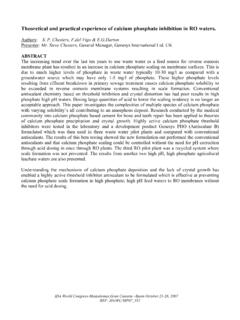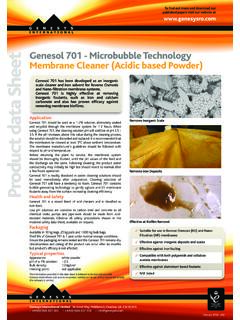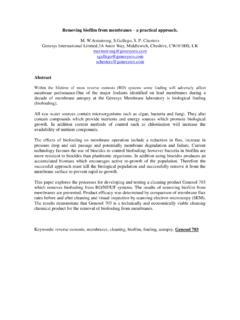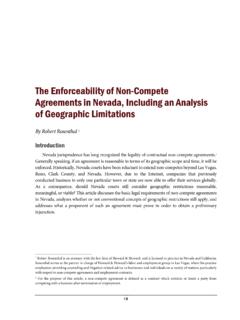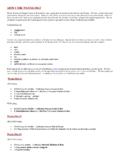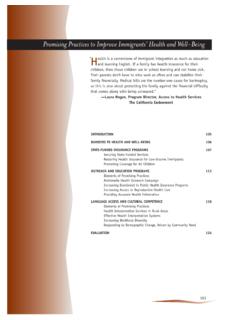Transcription of Problems of operation and main reasons for failure …
1 Problems of operation and main reasons for failure of membranes in tertiary treatment systems Valentina Lazarova1, Silvia Gallego2, Ver nica Garc a Molina3 and Philippe Roug 4. 1. Suez-Environment, 38 rue du pr sident Wilson, 78230 Le Pecq, France, 2. Genesys membrane Products, Plaza Luis Bu uel 4, Madrid, Spain, 3. Dow Water Solutions, Industriestra e 1, 77836 Rheinm nster, Germany, 4. Agbar Agua, Torre Agbar, avda. Diagonal 211, planta 13, Barcelona, Spain, Abstract This paper presents and discuss the results of the long term operation and monitoring of membrane fouling at several full-scale MF/RO water recycling facilities operated by Agbar in Spain.
2 It was demonstrated that membranes are very reliable treatment enabling the production of high-grade recycled water, well disinfected and with the removal of all priority substances. The high organic and salt concentrations of raw wastewater combined to extremely high variations justified the implementation of sand filtration to protect MF/RO membranes. membrane autopsy was used to better understand the predominant fouling mechanisms and optimise down-stream operation and membrane cleaning strategy. The main membrane pathologies are described with recommendation of an adequate cleaning strategy. Keywords: cleaning strategy, membrane autopsy, membrane fouling, microfiltration, reverse osmosis INTRODUCTION.
3 Agbar Agua is the principal operator of wastewater treatment plants in Spain (500 WWTP, 12,500,000 ). Over 28% of the total treated volume (1000 Mm3/yr) undergoes tertiary treatment for beneficial reuse mainly in the Mediterranean cost and the Balearic and Canaries Islands. The majority of the tertiary treatment trains includes only a disinfection step of UV irradiation or chlorination. The increasing demand of high quality recycled water with reduced total dissolved salt content promoted the implementation of advanced membrane treatments. Reverse osmosis (RO). and electrodialysis reversal (EDR) have been chosen to reduce total dissolved solids, thus enabling water recycling for urban and golf course irrigation, as well as the irrigation of salt sensitive crops.
4 Microfiltration (MF) has been chosen as the best available pre- treatment of RO, which was successfully used since 1995 in West Basin Water Recycling Plant in California in replacement of conventional lime clarification and filtration (Lazarova et all., 2003). At the end of 2002, according to a recent survey of WERF (Foussereau et al., 2003), over 25. recycling facilities used MF/RO technologies, from which 20 plants in the USA. More recently, 4. large tertiary treatment UF&MF/RO facilities have been constructed in Singapore in Bedok, Kranji, Seletar and Ulu Paladan with treatment capacities from 32,000 to 148,000 m3/d.
5 A number of pilot and full-scale investigations confirmed the advantages of MF and ultrafiltration (UF) as reliable pre- treatment stage before RO allowing a small footprint and high rejection level for many fouling agents at competitive costs. Nevertheless, because the high variation of wastewater quality in terms of concentrations of metals, silica, salinity and organic matters, the control of membrane fouling remains the major challenge in operation of membrane facilities. In this context, the main objective of this paper is to present the most common Problems of operation and analyse the reasons for failure of membranes used in MF/RO tertiary treatment schemes applied for the treatment of relatively high concentrated urban wastewater in terms of levels of organic matter and salinity.
6 Special attention was made on the investigation of RO fouling mechanisms and optimisation of membrane cleaning. 1. MATERIALS AND METHODS. 8 full-scale wastewater treatment plants (WWTP) in Spain with different membrane combinations as tertiary treatment have been evaluated (UF+RO, MBR+RO, EDR). From which, 4 MF/RO units implemented at two plants operated for over 3 to 5 years (Table 1), have been evaluated in details in terms of reliability of operation and control of fouling. Wastewater and recycled water characteristics have been followed on weekly basis using Standard Methods. Special attention has been dedicated on the control of membrane fouling and optimisation of cleaning procedure, in particular of RO membranes.
7 The concept of membrane autopsy has been applied to better understand the predominant fouling mechanisms and consequently, apply the most appropriate pre- treatment and cleaning strategies. Table 1. Main characteristics of investigated MF/RO water recycling facilities located in Spain Plant treatment tertiary treatment train and equipment index and capacity, Low pressure Pre- treatment Desalination (RO and EDR). start-up m3/d membranes Line 1 to 3: Reverse osmosis (3 steps, External MF, 168 units), Dow Filmtec BW 365FR;. Dual contact Memcor M10C, Plant 1, 12,000 Renewed by Ropur Toray TML20-370. sand filtration ( m, (2001) (4 lines) (2 steps, 126 units, 12 bar), (6 units) bar), 180.
8 Line 4: Electrodialysis reversal (1. modules module of 3 lines with 2 steps each 4,800 External MF, Pulsed-bed Plant 2 (12,000 of Memcor M10, Reverse osmosis (2 steps, 90 units, 12. sand filtration (2004) secondary ( m, bar), Dow Filmtec BW 30-365 FR. (3 units). treatment ) bar), 96 modules membrane autopsy was used as the most common way to understand the causes of the loss of membrane permeability and flux. This destructive technique allows evaluating both membrane polymer condition and foulant nature. membrane autopsy methodology may vary depending on type of foulant or problem suspected. In all cases, the general purpose is as follows: Testing integrity of membrane element and visual inspection, Visual inspection of membrane surface (after external housing removal), Figure 1.)
9 View of the flat sheet State of the membrane permeability and rejection cleaning rig used for membrane properties using a flat sheet test rig, autopsy Observations by electronic microscopy of the state of the polymer and/or the presence of deposits, Characterization of deposits detected on membrane surface by different analytical techniques. Fourier Transmission by Infrared (FTIR), X-ray Photoelectron Spectroscopy (XPS) and scanning electron microscope (SEM) connected to energy dispersive X-ray analysis (EDAX). have been used to characterises in more details the RO membranes fouling. Depending on foulant properties, other techniques may be used (Magnetic Nuclear Resonance, X-Ray Difraction, etc.)
10 Counting and identification of bacteria on the surface of the membrane . A detailed description of the analytical procedure is provided elsewhere (Darton et al., 2004). 2. Several samples of aged and/or fouled RO membranes situated either in the 1st and 2nd stages have been removed for an autopsy in a specialised laboratory. After external inspection, the first step consists in removal of various A4-size pieces of RO membranes, which were characterised by means of the flat sheet- test rigs under standard operating pressure, saline solution and flux conditions settled by membrane manufacturer (Figure 1).

